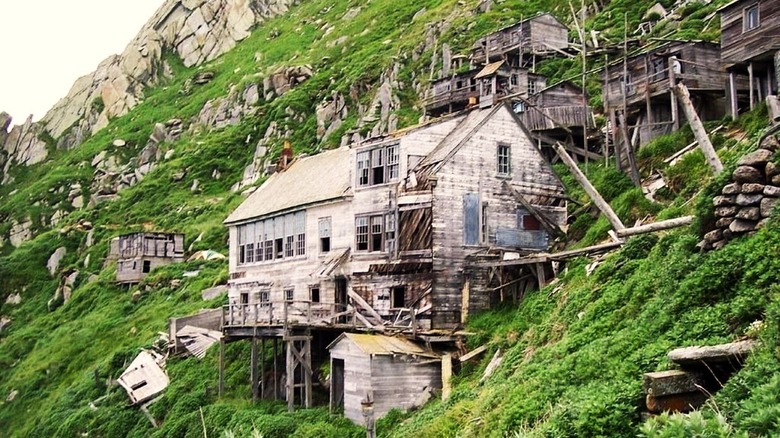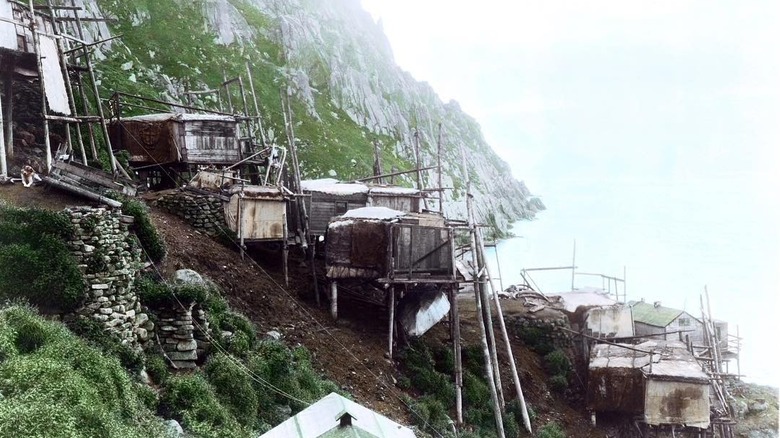
On a rugged, rocky isle sticking out like a lonely tooth, the remote coastal village of Ukivok, on Ugiuvak Island (also known as King Island), slumbers undisturbed surrounded by the icy sea. In the middle of the Bering Sea, this fascinating Alaskan wonder was once a thriving village on stilts, with its last residents leaving in the late 1960s.
Not only is America's least-visited state a destination of breathtaking parks, mountains, and wildlife, it is also a place rife with historic landmarks such
as Ukivok. The island is a poignant reminder of human resilience, a cautionary tale of shifting climate causing frequent storms and landslides, and of a wound inflicted by colonialism on Alaska Natives. In fact, the latter is the main reason the island was abandoned, as the Bureau of Indian Affairs closed the school in 1958, forcing children of school age into a boarding school in Nome nearly 100 miles away. Along with the children came their families, forcing the village's people to relocate to mainland Alaska.
While it is not possible to explore the island on foot today, a handful of cruise operators have included the island on their voyages throughout the years. The French carrier Ponant once offered a cruise including a circumnavigation of the island, though it received criticism because the information it shared with passengers on board was not subject to consultation with the King Island Native Community, who owns the island. Ukivok's history is tied to its Native community and historic roots. As such, it should be visited with respect, and under no circumstances should people land without a permit from the community.
Read more: The 5 Best Parks Where You Can See Bison Roam (Other Than Yellowstone), According To Visitors
Ukivok's History Explains Its Formation As A Village On Stilts

Unbeknownst to legendary explorer Captain James Cook -- who, in 1778, named the island after his Lieutenant James King -- the island was already called Ugiuvak. What Cook also didn't know was how old the island was, with its foundations dating back to the Paleozoic and Precambrian era –- predating dinosaurs by about 10 million years. Its rocky formation reflects the many changes occurred to this day, including coastal erosion and rock shifting, one of the factors that sealed the fate of Ukivok's communities.
From the sea, you can see dozens of houses still standing, some of them almost completely intact. For some houses, all that remains is the characteristic stilts they were built on. While King Islanders are believed to have inhabited the territory for thousands of years, the structures you can see today are more recent, and date back to the 19th century. The villagers used this system to stabilize the wooden structures on the rocky cliffs, as there was no flat land available. The stilt houses were built by the Aseuluk (meaning "people of the sea"), part of the Iñupiat Indigenous population of northwestern Alaska. About 200 people lived in Ugiuvak during its heyday, living off walrus, seal and fish, before school closures pushed the population out to Nome and other mainland locations.
Alaska is home to few ghost towns, remnants of old industries and perilous spots, such as the abandoned copper camp offering hikes, mill tours, and stunning icy views of the Wrangell-St. Elias National Park. With a geological history as old and varied as the earth itself, it's no surprise the Last Frontier has so many traces of natural, wild, and human history waiting to be followed by intrepid adventurers.
Ready to discover more hidden gems and expert travel tips? Subscribe to our free newsletter for access to the world's best-kept travel secrets.
Read the original article on Islands.












